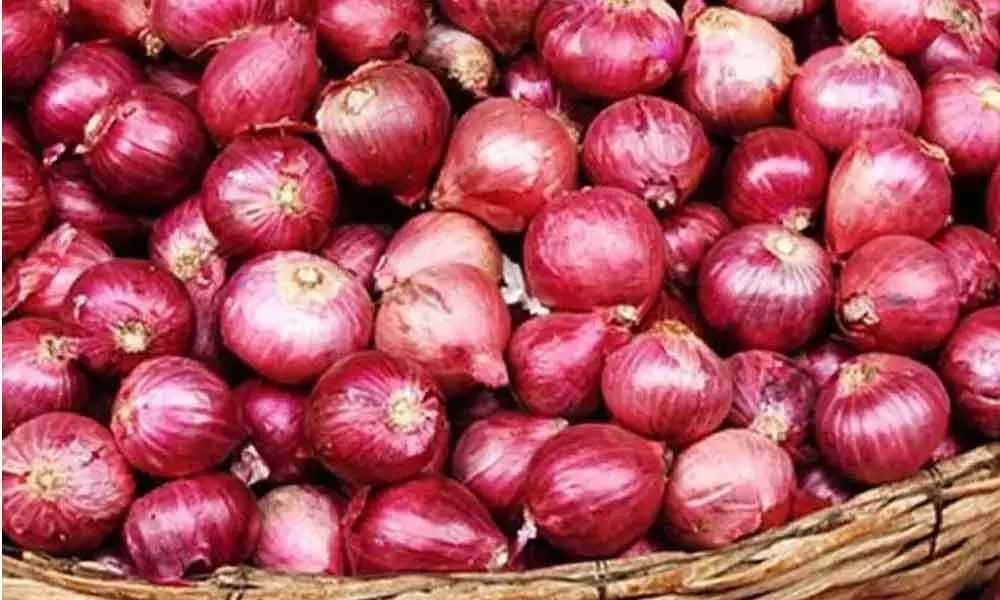Live
- Revanth calls for 10-day festivities from Dec 1
- ‘Storytelling’- a platform to share pain, inspire people
- Our govt will extented all help to young entrepreneurs: Ponnam
- 1,200 participate in Sahasra Galarchana at Tirumala
- IT Minister reassures govt support to start-ups
- Naidu, Pawan say it is Maha display of ‘people’s trust in PM’
- It’s only industrial corridor, not a Pharma City, CM clarifies
- Sathya Sai’s teachings of love worthy of emulation, says Guv
- Sowing the seeds of democracy
- Sudanese army recaptures capital of Sinnar State in central Sudan
Just In

The impact of skyrocketing onion prices is far and wide, to say the least.
The impact of skyrocketing onion prices is far and wide, to say the least. This bulbous vegetable is used every day in Indian kitchens - in curries, salads, samosas and what not.
With its price crossing Rs 200 a kg in some parts of the country, onion has more or less disappeared from our kitchens. Who will buy onions at that price and use them?
Chicken is far cheaper! Furthermore, onion was available at throwaway price and onion farmers were getting a paltry Rs 1 a kg at this time last year.
No surprise we are hearing about theft of onions as this vegetable has become precious commodity, costing Rs 2 lakh a tonne.
However, the wider implications of high onion prices came to the fore as data revealed that wholesale inflation rose this November thanks to higher inflationary pressures from food items.
As per official data released on Monday, wholesale inflation, measured as wholesale price index (WPI), rose to 0.58 per cent.
This key reading which influences RBI's monetary policy decisions and interest rate cuts was 0.16 per cent in October this year.
That means a near four-fold jump in the matter of one month. The primary reason for the spike in inflation is onion whose prices rose by a whopping 172 per cent in the last month compared to the prices prevailing in the same month a year ago.
Since March this year, onion prices zoomed by a staggering 450 per cent, making people teary-eyed, as there are supply constraints.
Some estimates put a shortfall of 1.6 lakh metric tonnes in the country this year. That is mainly due to damage to onion crop in Maharashtra, a leading producer of this vegetable.
Rough estimates indicate that 30 per cent of crop has been damaged in Maharashtra this time, owing to unseasonal rains.
To bridge the demand and supply gap, Centre has been making frantic efforts to import onions. Till date, it has put orders in place to import 21,090 tonnes from Egypt and Turkey.
The country may have to go for more imports to bring down the prices and stabilise them at affordable levels.
But these imports are a short-term measure.
Centre should initiate steps to see that onion cultivation is spread across the country so that there will be a stable supply even if some parts of the onion cultivation areas are affected by excess rains or rainfall deficit.
It should also enhance cold storage facilities in order to preserve onion stocks for a longer period.
Nevertheless, onion shortfall signals a larger food crisis cooking up in India. Importing food grains and staple food items doesn't bode well for a country which is home to the world's second largest population after its Communist neighbour, China.
Latest wholesale inflation data also revealed that apart from onions, prices of 20 other essential food items such as rice, wheat, pulses, etc, have also gone up in recent times.
That's a bad signal for the governments and people. Unless the governments put in place an efficient mechanism to monitor agriculture, country will continue to suffer supply side constraints when it comes to food items. It's time act, fast.

© 2024 Hyderabad Media House Limited/The Hans India. All rights reserved. Powered by hocalwire.com







